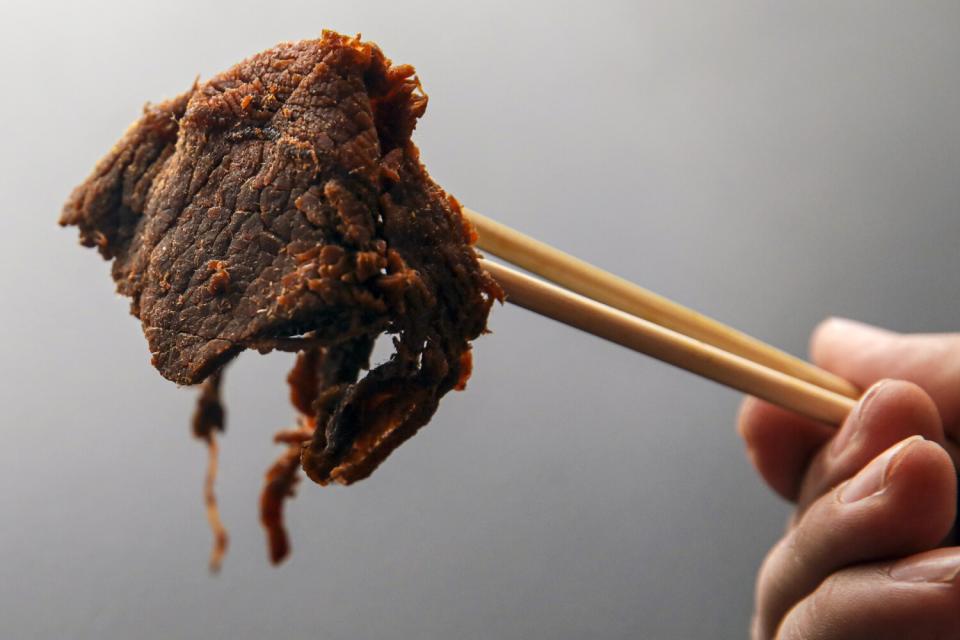Column: Border patrol officials couldn't explain how seizures of Chinese jerky prevent disease, so let me try

The email from U.S. Customs and Border Protection landed in my inbox with a dire warning.
"Animal Food Contraband from China Remains at Record Levels at LA/LB Seaport ... China is affected with Several Contagious and Deadly Animal Diseases."
Sounds serious, I thought. But when I opened the email and clicked on the pictures of the contraband, they depicted prepackaged, branded products for human consumption. I even recognized a few of them as nostalgic snacks from my mother's childhood in Taiwan. Similar products are sold in grocery stores all across Southern California, but the most nostalgic flavors are back home in Asia.
When friends and family members return from visiting family, it's a good bet that they'll try to bring a few packets of jerky, along with sour plum candies, moon cakes and pastries. Import regulations prohibit much of this activity, but nostalgia often overwhelms good sense.
I started to wonder exactly what Chinese jerky meant for human consumption had to do with animal diseases in China, so I called Jaime Ruiz, a spokesman for CBP and the author of the press release. Ruiz was unable to explain the connection between the seizures and infectious disease. He said the meat products were seized because they skirted import tariffs, did not obtain a USDA certificate and thus did not undergo a separate food safety inspection process in the U.S.
What did that have to do with contagious diseases affecting animal populations in China? Ruiz could not say, and he pointed me toward the U.S. Department of Agriculture for clarification.
I admit, I am weary of playing word and photo police with pandemic xenophobia. And I'm concerned that no one is listening. But I'm convinced that casual associations like these, where we gesture vaguely at the dangers of infectious disease while pointing the finger at China and anyone who could be mistaken for Chinese, are dangerous. When you see reports of a flood of "illegal meats from China" heading toward our ports, I see lots of moms, aunties and grandmas yearning for tastes of home. When you see a clumsily worded press release, I see Asian women getting spit on and pushed in the subway.
It's a mistaken association that we are still making three years into the pandemic. Earlier this month, the Chicago Sun-Times ran a random photo of commuters in Tokyo to illustrate a story about a new coronavirus variant. Last week the New York Times ran a photo of an unrelated, masked Asian American student at Stuyvesant High School to illustrate an online post about the Omicron variant's spread in New York City.
Authorities regularly broadcast their seizures of Chinese meat products at the port to burnish their public image as protectors of American borders. A lot of Chinese jerky, both permitted and smuggled, comes through the port. But when ambiguous associations like these are blasted out to major news organizations, they reach thousands of people who I fear will remember maybe three words out of the headline: "illegal," "Chinese" and "disease."
So pardon me if I take some time to actually check if the danger is real. I called USDA spokesman William Wepsala, who said that for diseases like African swine fever, there's evidence that it can persist for weeks in undercooked and processed meats. So if the jerky was improperly cooked, for example, it could spread infectious disease, Wepsala said.
On the USDA's website, a risk assessment identifies illegal entry of swine products and byproducts as the "largest potential pathway" for the entry of the African swine fever virus. However, if those products obtain a USDA certificate, then swine products and byproducts have negligible to low risk.
Sensible enough. But how would this jerky, intended for human consumption, make it to U.S. swine populations? Is Chinese jerky commonly fed to swine raised for human consumption? Wepsala was unable to say.

It's true that the origins of many of history's pandemics have hinged upon remote possibilities of disease transfer, such as the likelihood that Chinese beef jerky could carry a virus to a U.S. pig farm. Seizing smuggled meat products from any country does help protect against disease, and I'm all for enforcing import tariffs. But with an epidemic of anti-Asian violence as our backdrop, is it too much to ask that we be little bit more precise with language?
My last call was to my mom, who in her youth was an avid consumer of these products. Now they are more of a guilty pleasure, she said. They contain a lot of unhealthful preservatives and fats, and she was very against the idea of me writing about this or consuming any jerky myself. But as an Asian American health worker, she is positioned to bear the brunt of anti-Asian sentiments. When I read this release, I was concerned for her.
At the beginning of the pandemic, I wrote about how easily our fear of disease can inflame existing cultural and racial biases. Food is one of the main ways we express identity, community and belonging, but it can also be a way to paint people as foreigners, strangers and aliens.
There's much to be gained by overcoming these fears. And there might be some legal, safe and delicious Chinese jerky in it, too.
This story originally appeared in Los Angeles Times.

